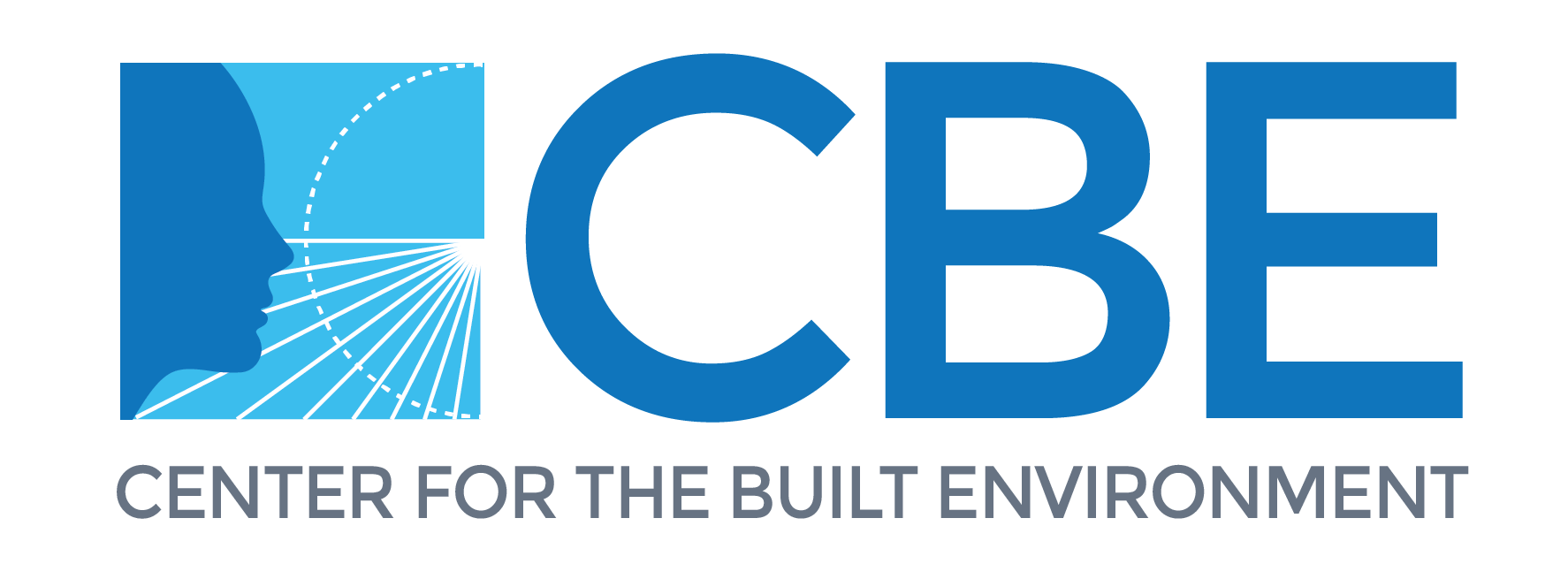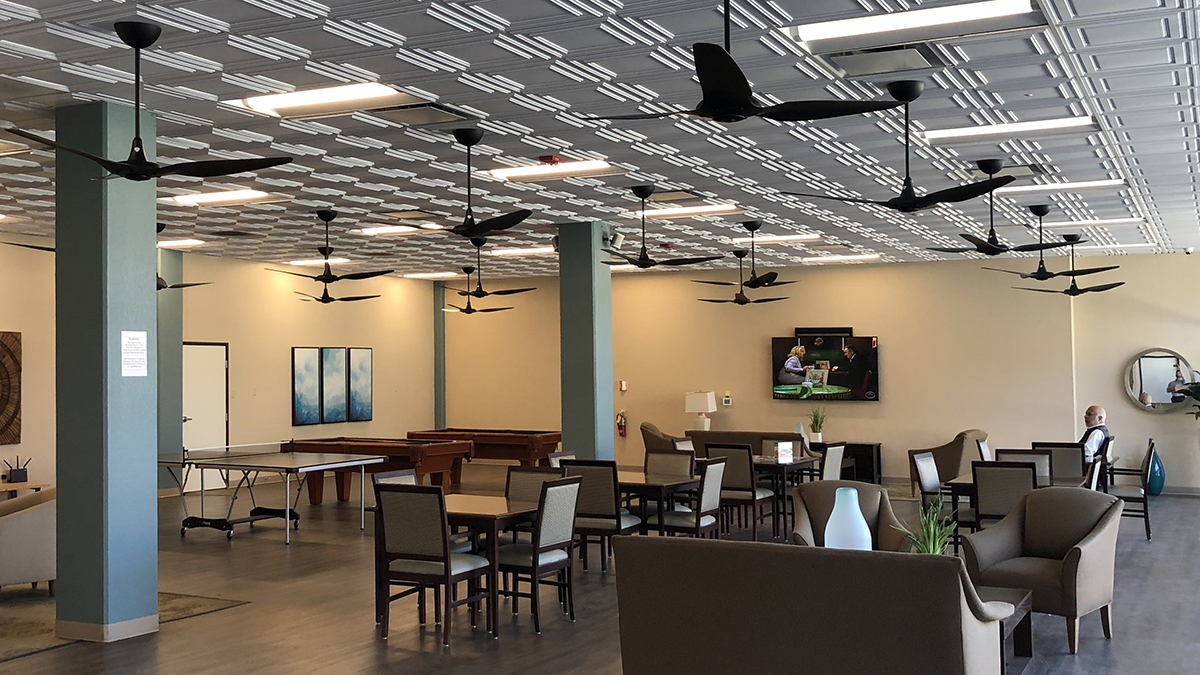Field demonstrations, laboratory studies and design resource development.
Status: Current
Funding Sources: California Energy Commision EPIC Funding CBE Membership Funding In-Kind Support from Big Ass Fans
Project Objective
This project demonstrated energy savings and improved comfort through the integration of smart ceiling fans and smart thermostats in retrofit applications. The work also identified and addressed market barriers to adoption of this strategy, provided guidance on how to implement this technology into energy efficiency retrofit programs and policies, and developed numerous industry resources for building industry professionals and others.
Project Results
In aggregate and normalized for building size, the field demonstrations showed 39% compressor energy savings during the cooling season. Energy savings varied widely by site, with savings as high as 71% and median savings of 15%. All commercial spaces with regular occupancy schedules showed savings, even before normalizing for warmer outdoor temperatures in following years. The largest site saved over $6,000 in cooling energy costs over the cooling season — a considerable amount for an affordable housing facility manager. Extensive full-scale laboratory tests led to the development of an advanced online ceiling fan design tool, with an accompanying design guide, and numerous papers listed below. Finally, the research team created a plan to improve codes and standards that would advance wider adoption of this strategy. Read a two-page summary about these results.
Field studies demonstrated 39% compressor energy savings during the cooling season, in aggregate, and the largest site saved over $6,000 in cooling energy costs. Assuming a modest 15% market penetration of this approach in California, over the next 15 years this can yield annual savings of $125M, and 537M pounds of CO2 emissions.
Significance to Industry
The advent of cooling spaces through air conditioning has provided thermal comfort that leads to improved satisfaction and productivity, especially in the last few decades, but with tremendous costs. Ninety percent of American homes have air conditioning, contributing to climate change and leading to physiological ‘addiction’ that causes people to become less tolerant of temperatures outside of a narrow range.
Air movement, such as through ceiling fans, can cool a person indoors but uses only a tiny fraction of the energy required by HVAC systems. New fans, using only one to eight watts, can offset a 6ºF increase in indoor air temperature. This improves occupants comfort and perceived air quality while decreasing energy consumption. Allowing higher indoor temperatures reduces a building’s total HVAC energy by an average of 5-7 percent per degree F, and by even more in climate zones where natural ventilation or evaporative cooling systems are used instead of compressor-based cooling, or in areas with a large number of air-side economizer hours (such as many parts of California).
Before the completion of this work, designers lacked guidance for designing rooms with ceiling fans (spacing, sizing, cooling effect). ASHRAE formed a new standard to stipulate standard methods of testing fans, and its Comfort Standard 55-2013 now has an integrated approach to evaluating comfort effects of air movement ranging from desirable air speeds.
Research Approach
The work included a demonstration pilot focusing on retrofit applications in affordable housing because the technology has the potential to meet this market segment’s need for increased occupant comfort, low cost per energy saving, low operational level of effort, and ease of retrofit. Multifamily buildings provide the opportunity to develop the solution and demonstrate its application in both dwelling units and common areas. Results from tests in common areas include spaces that will inform commercial application opportunities.
An interdisciplinary team from industry and academia installed 99 ceiling fans and 12 thermostats in four affordable multifamily housing sites in California’s Central Valley. The innovative integrated solution includes a Haiku ceiling fan from Big Ass Fans and smart or communicating thermostats, such as the EcoBee. The SenseME comfort based ceiling fan controller embedded in the Haiku fan will optimize energy use and occupant comfort. This integrated solution provides a higher level of energy-comfort optimization by automatically increasing setpoints during cooling mode with auto-adjusted fan speed for comfort, and automatically de-stratifying in heating mode. The work also included a series of laboratory tests to discovers the impact of various parameters: multiple fans in a space, ceiling height and fan diameter. The laboratory studies, along with measurements in many case studies buildings, lead directly to the development of the design tool and guide.
Publications and Reports
Miller, D., P. Raftery, M. Nakajima, S. Salo, L. Graham, T. Peffer, M. Delgado, H. Zhang, G. Brager, D. Douglass-Jaimes, G. Paliaga, S. Cohn, M. Greene, and A. Brooks. 2021. Cooling energy savings and occupant feedback in a two year retrofit evaluation of 99 automated ceiling fans staged with air conditioning. Energy and Buildings, Volume 251. August. https://doi.org/10.1016/j.enbuild.2021.111319 https://escholarship.org/uc/item/7752j100
Raftery, P., D. Miller, H. Zhang, T. Peffer, G. Brager, L.T. Graham, E. Present, E. Arens, D. Douglas-Jaimes, G. Paliaga, A. Brooks, S. Cohn, and M. Greene. 2020. Integrating smart ceiling fans and communicating thermostats to provide energy-efficient comfort. Final report to CEC. April. https://escholarship.org/uc/item/91z0m3xw
Raftery, P., and D. Douglass-Jaimes. 2020. Ceiling fan design guide. CBE Report. March. https://escholarship.org/uc/item/6s44510d
Chen W., H. Zhang, E. Arens, M. Luo, Z. Wang, L. Jin, J. Liua, F. Bauman, and P. Raftery, 2020. Ceiling-fan-integrated air conditioning: Airflow and temperature characteristics of a sidewall-supply jet interacting with a ceiling fan. Building and Environment, Volume 171, March https://doi.org/10.1016/j.buildenv.2020.106660 https://escholarship.org/uc/item/8cj7n6ps
Parkinson, T., P. Raftery, and E. Present, 2020. Spatial uniformity of thermal comfort from ceiling fans blowing upwards. Proceedings ASHRAE 2020 Winter Conference, Orlando, FL, February.https://escholarship.org/uc/item/5fs9q6fq
Ceiling Fans Case Studies, 2019. The Bullitt Center, Seattle WA.; Coastal Biology Building, UC Santa Cruz; Franco Center Apartments, Stockton, CA
He, Y., W. Chen, Z. Wang, and H. Zhang. 2019. Review of fan-use rates in field studies and their effects on thermal comfort, energy conservation, and human productivity. Energy and Buildings. Volume 194, 1 July 2019, Pages 140-162. DOI: 10.1016/j.enbuild.2019.04.015. https://escholarship.org/uc/item/7hx9338z
Present, E., P. Raftery, G. Brager and L. T. Graham. 2019. Ceiling fans in commercial buildings: In situ airspeeds and practitioner experience. Building and Environment. 147 (2019) 241–257. https://doi.org/10.1016/j.buildenv.2018.10.012 https://escholarship.org/uc/item/84h3z7nx
Raftery, P., J. Fizer, C. Wenhua, Y. He, H. Zhang, E. Arens, S. Schiavon and G. Paliaga. 2019. Ceiling fans: Predicting indoor air speeds based on full scale laboratory measurements. Building and Environment, May. https://doi.org/10.1016/j.buildenv.2019.03.040 https://escholarship.org/uc/item/4p479663
Gao, Y., H. Zhang, E. Arens, E. Present, B. Ning, Y. Zhai, J. Pantelic, M. Luo, L. Zhao, Paul R. and S. Liu. 2017. Ceiling fan air speeds around desks and office partitions. Building and Environment. Volume 124, 1 November, pp. 412-440. DOI: 10.1016/j.buildenv.2017.08.029 https://escholarship.org/uc/item/3pq2j9mh

